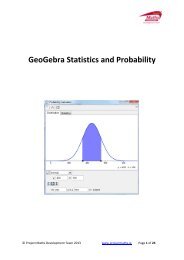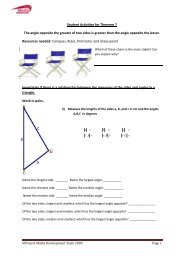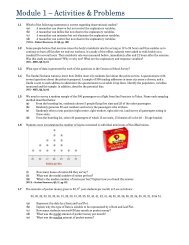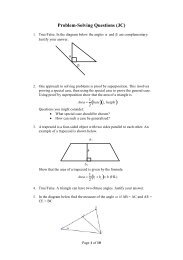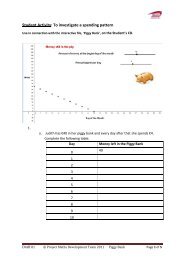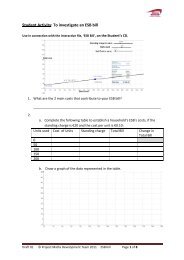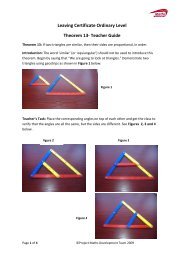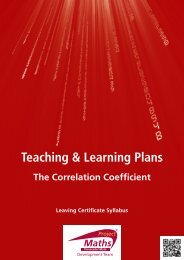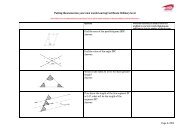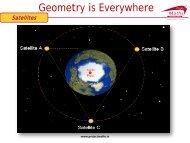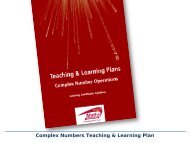Teaching & Learning Plan 10 - Project Maths
Teaching & Learning Plan 10 - Project Maths
Teaching & Learning Plan 10 - Project Maths
You also want an ePaper? Increase the reach of your titles
YUMPU automatically turns print PDFs into web optimized ePapers that Google loves.
<strong>Teaching</strong> & <strong>Learning</strong> <strong>Plan</strong>s<strong>Plan</strong> <strong>10</strong>: Trigonometric FunctionsLeaving Certificate Syllabus
The <strong>Teaching</strong> & <strong>Learning</strong> <strong>Plan</strong>sare structured as follows:Aims outline what the lesson, or series of lessons, hopes to achieve.Prior Knowledge points to relevant knowledge students may already have and alsoto knowledge which may be necessary in order to support them in accessing this newtopic.<strong>Learning</strong> Outcomes outline what a student will be able to do, know and understandhaving completed the topic.Relationship to Syllabus refers to the relevant section of either the Junior and/orLeaving Certificate Syllabus.Resources Required lists the resources which will be needed in the teaching andlearning of a particular topic.Introducing the topic (in some plans only) outlines an approach to introducing thetopic.Lesson Interaction is set out under four sub-headings:i. Student <strong>Learning</strong> Tasks – Teacher Input: This section focuses on teacher inputand gives details of the key student tasks and teacher questions which move thelesson forward.ii.Student Activities – Possible and Expected Responses: Gives details ofpossible student reactions and responses and possible misconceptions studentsmay have.iii. Teacher’s Support and Actions: Gives details of teacher actions designed tosupport and scaffold student learning.iv.Checking Understanding: Suggests questions a teacher might ask to evaluatewhether the goals/learning outcomes are being/have been achieved. Thisevaluation will inform and direct the teaching and learning activities of the nextclass(es).Student Activities linked to the lesson(s) are provided at the end of each plan.
<strong>Teaching</strong> & <strong>Learning</strong> <strong>Plan</strong> <strong>10</strong>:Trigonometric FunctionsAims• To help students to graph trigonometric functions sin x, cos x and tan x• To recognise the period and range of each function• To enable students to relate sin x and cos x to the unit circle• To reinforce understanding of the terms function, domain, range, period,inverse function, asymptotePrior KnowledgeStudents should be familiar with the introduction to trigonometry (T&L <strong>Plan</strong> 8) and theunit circle (T&L <strong>Plan</strong> 9)<strong>Learning</strong> OutcomesAs a result of studying this topic, students will be able to• plot the graph of y= sin x, where x is an angle in standard position in theunit circle by projecting the y coordinates (sin x) of points on the unit circleonto an x-y Cartesian plane [This will be done for more than one revolutionof the circle to emphasise the periodic nature of the functions. As smallintervals are used the non linearity will be emphasised, and they will seethat these graphs form smooth curves, which are “rounded” at the top andbottom.]• recognise the periodicity of y = sin x, and be able to give the value of theperiod and the range• explain why y = sin x is a function for all values of x and why its inverse isnot a function for all values of x but could be if we restricted the x-values[more detail on this later in inverse functions]• solve equations of the form, from the graph, for the domainplotted• plot the graph of y= cos x by plotting the x coordinates of points on theunit circle against the corresponding angle in standard position, on an x-yCartesian plane• plot graphs of sin x, cos x and tan x using tables• plot graphs of the form a sin x, a cos x and state their period and range,and explain the effect of changing the value of aplot graphs of the form sin• bx, cos bx, state their period and range andexplain the effect of changing the value of b© <strong>Project</strong> <strong>Maths</strong> Development Team 2009 www.projectmaths.ie 1
<strong>Teaching</strong> & <strong>Learning</strong> <strong>Plan</strong> <strong>10</strong>: Trigonometric Functions• state the period and range of graphs of the form asin bx, acos bx fora, b ∈ N• solve equations of the type y = asin bx, y =acos bx for the domain used inthe graph• sketch functions of the form asin bx or a cos bx for a, b ∈ N from aknowledge of the period and range and the shape of the functionRelationship to Leaving Certificate SyllabusSub-topicsHigher Level2.3 Trigonometry Graph the trigonometric functions sine, cosine, tangent.Graph trigonometric functions of type asin nθ, acos nθ fora, n ∈ N.Resources RequiredCompasses, protractors, clear rulers, pencils, formulae and tables booklet, Geogebra,Autograph, Perspex Model of Unit Circle (last 3 desirable but not essential)NoteThe CD icon is used throughout this document to indicate that there is a resourceon the Student Disc relating to this topic.© <strong>Project</strong> <strong>Maths</strong> Development Team 2009 www.projectmaths.ie 2
© <strong>Project</strong> <strong>Maths</strong> Development Team 2009 www.projectmaths.ie KEY: » next step • student answer/response 3<strong>Teaching</strong> & <strong>Learning</strong> <strong>Plan</strong> <strong>10</strong>: Trigonometric FunctionsStudent <strong>Learning</strong> Tasks:Teacher Input»» We have seen on the unitcircle that sin, cos and tanvary as the angle variesfrom 0° to 360°. The sinfunction is represented bythe y coordinate on theunit circle.»»Using Student Activity 1A,project the values of the ycoordinate, which is sin xonto the Cartesian plane toget a graph of y= sin x0 ≤ x ≤ 570°»»Describe the graph StudentActivity 1B Q 1.Student Activities: Possibleand Expected Responses»» Students plot the pointsand join them in a smoothcurve.• It consists of repeatingpatterns.• It has a max of 1 and a minof -1.• The graph is “rounded” –no sharp points.Lesson InteractionTeacher’s Support andActions»»Show http://www.projectmaths.ie/system/files/Presentation%20London%20eye%20sine.pptx and Perspex Model ofunit circle.»»Distribute Student Activity1.»» Tell students they will needa clear ruler and pencil.»» Ask individual students todescribe the graph in theirown words.Checking Understanding»» Does this presentationhelp students in the task ofplotting the graphy=sin x?
© <strong>Project</strong> <strong>Maths</strong> Development Team 2009 www.projectmaths.ie KEY: » next step • student answer/response 4<strong>Teaching</strong> & <strong>Learning</strong> <strong>Plan</strong> <strong>10</strong>: Trigonometric FunctionsStudent <strong>Learning</strong> Tasks:Teacher InputStudent Activities: Possibleand Expected ResponsesTeacher’s Support andActions»» Show an animation of thisexercise from Autograph.(File, New Extras Page,Trigonometry, sin )»» See also (scroll to end ofpage) piston animation:http://www.intmath.com/Trigonometric-graphs/2_Graphs-sine-cosine-period.phpChecking Understanding»» Does the animationsummarise the exercise forstudents and give themincreased understanding ofthe relationship betweensin x and the y-coordinateon the unit circle?»» Any function which isrepeating such that f(x)= f(x+c) , where c is aconstant is called a periodicfunction.»»GeoGebra interactivewebpage f(x) =asinx. Setslider with a=1»» We refer to the length ofthe repeating pattern onthe x- axis as the periodand the max and miny values are the rangewritten as[min value, max value]»» Write down the period andrange of y=sinx StudentActivity 1B Q 2 and 3.• Period = 360°• Range = [-1,1]
© <strong>Project</strong> <strong>Maths</strong> Development Team 2009 www.projectmaths.ie KEY: » next step • student answer/response 5<strong>Teaching</strong> & <strong>Learning</strong> <strong>Plan</strong> <strong>10</strong>: Trigonometric FunctionsStudent <strong>Learning</strong> Tasks:Teacher Input»»Is y=sin x a function?Student Activity 1B Q4»»Is the inverse of y=sin x afunction? Student Activity1B Q5.»»Explain your answer.»»Complete Student Activity1B Q6 and 7.»» Having seen the connectionbetween y = sinx andmotion in a circle, we willnow plot the graph ofy=sin x using a table ofvalues, then y= 2sinx andy= 3sin x, using the sameaxes and scale.Student Activities: Possibleand Expected Responses• Students explain in StudentActivity 1B Q4 that foreach value of x there isonly one value of y, hencey=sin x is a function.»» Students explain that forany y value there is aninfinite number of x values,so the inverse of y=sin x isnot a function.»» They may also draw ahorizontal line throughany value of y in therange, showing that it hasmultiple solutions.»» Students plot thegraphs on graph paperaccompanying StudentActivity 2 using differentcolours for each graph.Teacher’s Support andActions»» Remind students that afunction is a set of orderedpairs, where each x valuehas one unique y value.»»Distribute Student Activity2.Checking Understanding»» Do students rememberwhat a function is?»» Can they explain why theinverse of y=sin x is not afunction?»» Can students solve theequation sin x=0.5?
<strong>Teaching</strong> & <strong>Learning</strong> <strong>Plan</strong> <strong>10</strong>: Trigonometric FunctionsStudent <strong>Learning</strong> Tasks:Teacher Input»» What is the effect ofvarying a? StudentActivity 2.»» If this was a soundwave what effect doyou think it would haveon the sound to changethe value of a?»» In the functiony=a sin bx we haveseen the effect ofvarying a, and now wewill keep a constant ata=1, and vary b.»»Fill in Student Activity3.Student Activities: Possibleand Expected Responses• The range changes. Therange is [-a, a]• The volume would increaseas a increased.»» Students fill in the tableand plot the graphs in 3different colours (StudentActivity 3).»»Students fill in StudentActivity 3.Teacher’s Support and Actions Checking Understanding»» If required give students some helpin making this conclusion.»»Distribute Student Activity 3.»» Remind students that they areplotting the functionsf : x → sin xg : x → sin 2xh : x → sin 3x»» Do all studentsunderstand that in theequation y=a sin xthe period remainsunchanged as a changesand that only the rangechanges?»» Are students keepingthe correct shape on thecurves even when theyhave fewer points to plotfor each cycle?»»What is the effect ofvarying b?• As b varies the periodvaries.»» Students should be able to movefrom the specific to the generalhere and should be allowed to tryit out on their own first.»»Using GeoGebra interactivewebpage show graph ofy=a sin b x, varying a and b usingthe sliders.© <strong>Project</strong> <strong>Maths</strong> Development Team 2009 www.projectmaths.ie KEY: » next step • student answer/response 6
© <strong>Project</strong> <strong>Maths</strong> Development Team 2009 www.projectmaths.ie KEY: » next step • student answer/response 7<strong>Teaching</strong> & <strong>Learning</strong> <strong>Plan</strong> <strong>10</strong>: Trigonometric FunctionsStudent <strong>Learning</strong> Tasks:Teacher Input»» How can you calculate theperiod given b?Student Activities: Possibleand Expected Responses• When b is 1, the period is2π rad = 360°. When b=2the period is π rad = 180°.Teacher’s Support andActionsChecking Understanding»» Can students now calculatethe period and range ofany function of the typey=a sin bx, from the valuesof a and b?• In general the period is»»Use examples of functionsof this type to check.»» If this was a sound wavewhat would be the effectof varying b?Note: Students do not need toknow this for the syllabus, but itis good for real life context.»»We saw how sin x is they-coordinate of a point onthe circumference of theunit circle and that cos x isthe x-coordinate. Hence byplotting the x coordinatesof points on the unit circleonto a Cartesian plane weshould get the graph ofy=cos x.• The frequency and hencethe pitch of the note wouldchange, increasing as bincreased.»» Show an animation of thisexercise from Autograph.(File, New Extras Page,Trigonometry, cos) andPerspex model of unitcircle.» » Show, using aGeoGebra interactivewebpage, where sin isdragged 90° to the leftgiving the cosine function.
© <strong>Project</strong> <strong>Maths</strong> Development Team 2009 www.projectmaths.ie KEY: » next step • student answer/response 8<strong>Teaching</strong> & <strong>Learning</strong> <strong>Plan</strong> <strong>10</strong>: Trigonometric FunctionsStudent <strong>Learning</strong> Tasks:Teacher Input»» Describe the graph ofy = cos x»» Having seen the connectionbetween y = cos x andmotion in a circle, we willnow plot the graph ofy = cos x using a table ofvalues, then y = 2cosx andy = 3cosx, using the sameaxes and scale (StudentActivity 4).»» What is the period andrange of y = cosx,y = 2cosxand y = 3cosx?Student Activity 4.»» What is the effect ofvarying a? Student Activity4.»»In the function y=a cos bxwe have seen the effect ofvarying a, and now we willkeep a constant and vary b.Student Activities: Possibleand Expected Responses• Its shape is the same as thesine graph. It is the graphof sin x shifted 90° to theleft.• It is periodic with a periodof 360° and a range of[-1,1]»» Students plot the graphsusing different colours foreach graph.»»Students fill in StudentActivity 4.• The range changes. Therange is [-a,a]• Students fill in the tableand plot the graphs in 3different colours. StudentActivity 5.Teacher’s Support andActions»»Distribute StudentActivity 4.»»Distribute StudentActivity 5.Checking Understanding»» Are students now able todescribe the graph ofy = cos x in terms of periodicityand range, having worked withy = sin x?»» Do all students understand thatin the equation y = acos x, theperiod remains unchanged asa changes and that only therange changes?»» Are students keeping thecorrect shape on the curveseven when they have fewerpoints to plot for each cycle?
© <strong>Project</strong> <strong>Maths</strong> Development Team 2009 www.projectmaths.ie KEY: » next step • student answer/response 9<strong>Teaching</strong> & <strong>Learning</strong> <strong>Plan</strong> <strong>10</strong>: Trigonometric FunctionsStudent <strong>Learning</strong> Tasks:Teacher Input»» What is the period andrange of y = cos xy = cos 2xand y = cos 3x?Student Activity 5.Student Activities: Possibleand Expected Responses»»Students fill in StudentActivity 5.Teacher’s Support and Actions Checking Understanding»»What is the effect of varyingb?• As b varies the periodvaries.»»How can you calculate theperiod given b?• When b is 1, the period is2π rad = 360°. When b=2the period is π rad = 180°.• In general the period is»» Students may need some helpin moving from the specific tothe general here; allow themto try it out on their own first.»» Can students nowcalculate the period andrange of any functionof the type y=a cos bx,from the values of a andb?»» Use more examples offunctions of this type tocheck understanding.»» Sketch the graphs of thefunctions on StudentActivity 6, without tables ofvalues, by first calculatingthe period and range,and knowing the shape offunctions of the typey=a sin bx and y=a cos bx.»» We will now look at thegraph of the functiony=a tan x.»» Students make 4 evenlyspaced marks on thex axis and mark therange on the y axis, andplot the curves.»»Distribute Student Activity 6.»» Walk around, looking at thegraphs, referring students backto the previous activity sheetswhen they are in doubt.»»Show GeoGebra interactivewebpagey=a sin bx and y=a cos bx»»Distribute Student Activity 7.»» Are students able tosketch graphs of theform y=a sin bx andy=a cos bx from thevalues of period andrange?
© <strong>Project</strong> <strong>Maths</strong> Development Team 2009 www.projectmaths.ie KEY: » next step • student answer/response <strong>10</strong><strong>Teaching</strong> & <strong>Learning</strong> <strong>Plan</strong> <strong>10</strong>: Trigonometric FunctionsStudent <strong>Learning</strong> Tasks: TeacherInput»» What is the relationshipbetween sin, cos and tan of anangle x?»» What measurement in thediagram represents for instancethe tan
© <strong>Project</strong> <strong>Maths</strong> Development Team 2009 www.projectmaths.ie KEY: » next step • student answer/response 11<strong>Teaching</strong> & <strong>Learning</strong> <strong>Plan</strong> <strong>10</strong>: Trigonometric FunctionsStudent <strong>Learning</strong> Tasks:Teacher Input»»Describe how tan x variesas x approaches 90°?Student Activities: Possibleand Expected Responses• As the angle approaches90°, tan x increases veryrapidly and tends to + ∞ as itapproaches 90° from the left,and to - ∞ as it approaches90° from the right.Teacher’s Support andActions»»Show the GeoGebrainteractive webpage ony=tan xChecking Understanding»» Do students appreciatethe phrase “tends toinfinity” as x tends to90°?»» What is the range of • [-∞,+∞]Are students able to plot they = tan x (Student Activity7C).graph of y = tan x and list theperiod and range?»»What is the tan 90°? • Undefined»»The graph of y = tan x approaches a line as x approaches for example, 90° and 270°. These lines are called ASYMPTOTES – astraight line to which thegraph becomes closer andcloser but doesn’t touch.»» Students draw in linesy = –90°y = 90°y = 270°»»Draw in the asymptotes onthe graph.
© <strong>Project</strong> <strong>Maths</strong> Development Team 2009 www.projectmaths.ie KEY: » next step • student answer/response 12<strong>Teaching</strong> & <strong>Learning</strong> <strong>Plan</strong> <strong>10</strong>: Trigonometric FunctionsStudent <strong>Learning</strong> Tasks:Teacher InputReflection»» Write down 3 things youlearned about todaytrigonometric functions.Student Activities: Possible andExpected Responses1. Draw the graph of sin x,a sin x, sin bx and a sin bx.2. Find the period and range of sin x,a sin x, sin bx and a sin bx.3. Concept of varying a and b iny = a sin bx4. Draw the graph of cos x,a cos x, cos bx and a cos bx.5. Find the period and range of cos x,a cos x, cos bx and a cos bx.6. Concept of varying a and b iny = a cos bxTeacher’s Support andActions»» Circulate and takenote particularly ofany questions studentshave and help them toanswer them.CheckingUnderstanding»» Have all studentslearned andunderstood theseitems?»» Are they using theterminology withunderstanding andcommunicating witheach other using theseterms?7.Draw the graph ofy = tan x.8. Find the period and range of tan x.9.Concept of asymptotes»»Write down anything youfound difficult.<strong>10</strong>. Draw asymptotes on the graphy = tan x.»»Write down any questionsyou may have.
Student Activity 1AGraph of y= sin x Complete the projection of sin values from the unit circle onto the Cartesian plane on the right and then join the points with a smooth curve.<strong>Teaching</strong> & <strong>Learning</strong> <strong>Plan</strong> <strong>10</strong>: Trigonometric FunctionsStudent Activity 1Student Activity 1B1. Describe the graph of y = sin x.____________________________________________________________________________________________2. What is the period of y = sin x?____________________________________________________________________________________________3. What is the range of y = sin x?_____________________________________________________________________________________________4. Is y = sin x a function? Explain._____________________________________________________________________________________________5. Is the inverse of y = sin x a function? Explain._ ______________________________________________________________________________6. Using the graph solve for x the equation sin x = 0.5_________________________________________________________________________7. How many solutions has the equation in Q6?_ ______________________________________________________________________________© <strong>Project</strong> <strong>Maths</strong> Development Team 2009 www.projectmaths.ie13
Using a calculator, or the unit circle, fill in the table for the following graphs and plot all of them using the same axes.y = sin x, y = 2sin x, y = 3sin x Use different colours for each graph.x/º -90 -60 -30 0 30 60 90 120 150 180 2<strong>10</strong> 240 270 300 330 360sin x2sin x3sin xIn the function, what is the effect on the graph of varying a in asin x?_ ___________________________________________________________________________________________________________________________________________________________________________________________________________________________________________________________________________________________________________________________________________________________________________________________________________________________________________________________________________________________________________________________________________________________14<strong>Teaching</strong> & <strong>Learning</strong> <strong>Plan</strong> <strong>10</strong>: Trigonometric FunctionsStudent Activity 2y = sin xy = 2sin xy = 3sin xy = asin xPeriod Range© <strong>Project</strong> <strong>Maths</strong> Development Team 2009 www.projectmaths.ie
Fill in the table first, and using the same axes but different colours for each graph, draw the graphs of:y = sin x, y = sin 2x = sin (2 x x), y = sin 3x = sin (3 x x) Graphs of the form y = sin bxIn the graph of y = sin bx, what is the effect on the graph of varying b in sin bx?________________________________________________________________________________________________________________________________________________________________________________________________________________________________________________________________________________________________15<strong>Teaching</strong> & <strong>Learning</strong> <strong>Plan</strong> <strong>10</strong>: Trigonometric FunctionsStudent Activity 3x/º 0 15 30 45 60 75 90 <strong>10</strong>5 120 135 150 165 180 195 2<strong>10</strong> 225 240 255 270 285 300 315 330 345 360sin x2xsin 2x3xsin 3xy = sin xy = sin 2xy = sin 3xy = sin bxPeriod Range© <strong>Project</strong> <strong>Maths</strong> Development Team 2009 www.projectmaths.ie
Using a table, find the coordinates for the following graphs and plot all of them using the same axes: y = cos x, y = 2cos x, y = 3cos xx/º -90 -60 -30 0 30 60 90 120 150 180 2<strong>10</strong> 240 270 300 330 360cos x2cos x3cos xIn the function y = acos x , what is the effect on the graph of varying a in acos x?_________________________________________________________________________________________________________________________________________________________________________________________________________________________________________________________________________________________________________________________________________________________________________________________________________________________16<strong>Teaching</strong> & <strong>Learning</strong> <strong>Plan</strong> <strong>10</strong>: Trigonometric FunctionsStudent Activity 4y = cos xy = 2cos xy = 3cos xPeriod Range© <strong>Project</strong> <strong>Maths</strong> Development Team 2009 www.projectmaths.ie
By filling in a table first, and using the same axes but different colours for each graph, draw the graphs ofIn the graph of y = acos bx, what is the effect on the graph of varying b in cosbx?_______________________________________________________________________________________________________________________________________________________________________________________________________________________________________________________________________________________________17<strong>Teaching</strong> & <strong>Learning</strong> <strong>Plan</strong> <strong>10</strong>: Trigonometric FunctionsStudent Activity 5x/º 0 15 30 45 60 75 90 <strong>10</strong>5 120 135 150 165 180 195 2<strong>10</strong> 225 240 255 270 285 300 315 330 345 360cos x2xcos 2x3xcos 3xy = cos xy = cos 2xy = cos 3xy = cos bxPeriod Range© <strong>Project</strong> <strong>Maths</strong> Development Team 2009 www.projectmaths.ie
Sketch each of the following graphs: (0°≤ x ≤ 360°) y = 4sin x Period =_________________ Range =_________________Sketch each of the following graphs: (0°≤ x ≤ 360°) y = cos4 x Period =_________________ Range =_________________Sketch each of the following graphs: (0°≤ x ≤ 360°) y = 2sin 3x Period =_________________ Range =_________________<strong>Teaching</strong> & <strong>Learning</strong> <strong>Plan</strong> <strong>10</strong>: Trigonometric FunctionsStudent Activity 6© <strong>Project</strong> <strong>Maths</strong> Development Team 2009 www.projectmaths.ie18
|∠AOA’| |∠AOA’’| |∠AOA’’’| |∠AOA’’’’| |∠AOA’’’’’|30.00° 60.00° 75.00° 80.00° 85.00°Using the diagram of the unit circle, read the approximate value of the tan of the angles in<strong>Teaching</strong> & <strong>Learning</strong> <strong>Plan</strong> <strong>10</strong>: Trigonometric FunctionsStudent Activity 7Student Activity 7Ay=tan xthe table using the trigonometric ratios.Angle θ/º 0 30 60 75 80 85tan θ© <strong>Project</strong> <strong>Maths</strong> Development Team 2009 www.projectmaths.ie19
x/º -90 -75 -60 -45 -30 0 30 45 60 75 90 <strong>10</strong>5 120 135 150 180 2<strong>10</strong> 225 240 255 270 285 300 330 360tan x20<strong>Teaching</strong> & <strong>Learning</strong> <strong>Plan</strong> <strong>10</strong>: Trigonometric FunctionsStudent Activity 7Student Activity 7BBy filling in a table first, and using the same axes but different colours for each graph, draw the graphs ofStudent Activity 7Cy = tan x Period Range© <strong>Project</strong> <strong>Maths</strong> Development Team 2009 www.projectmaths.ie



